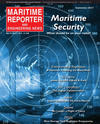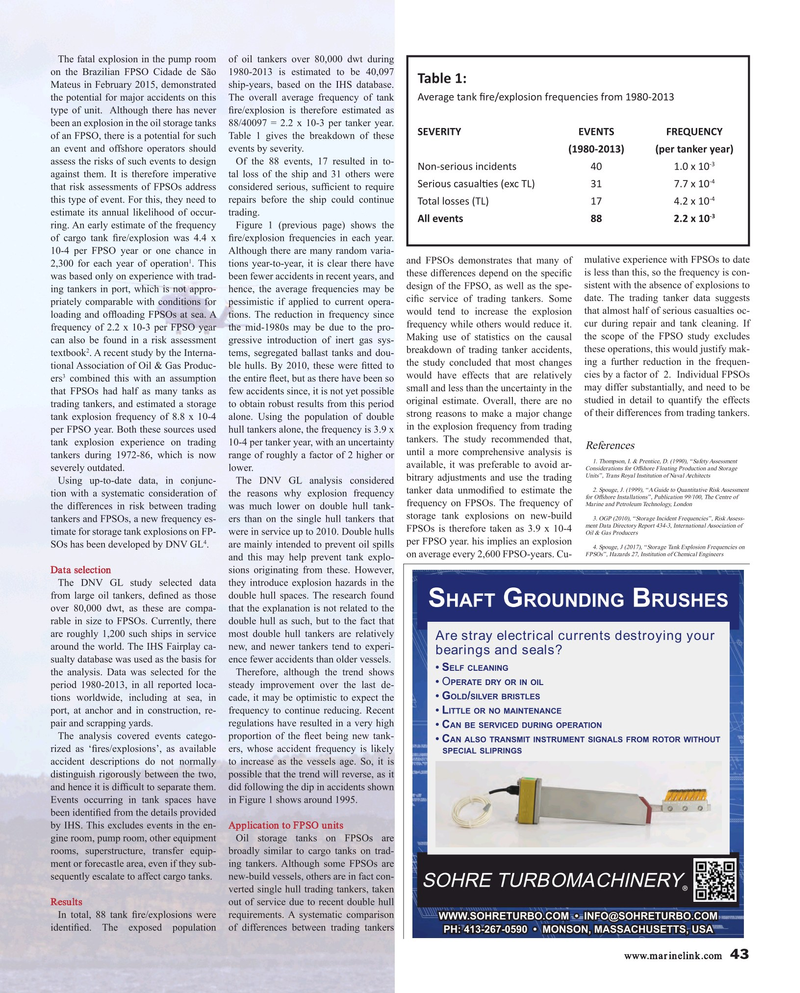
Page 43: of Maritime Reporter Magazine (September 2017)
U.S. Navy Quarterly
Read this page in Pdf, Flash or Html5 edition of September 2017 Maritime Reporter Magazine
The fatal explosion in the pump room of oil tankers over 80,000 dwt during on the Brazilian FPSO Cidade de São 1980-2013 is estimated to be 40,097
Table 1:
Mateus in February 2015, demonstrated ship-years, based on the IHS database.
Average tank ? re/explosion frequencies from 1980-2013 the potential for major accidents on this The overall average frequency of tank type of unit. Although there has never ? re/explosion is therefore estimated as been an explosion in the oil storage tanks 88/40097 = 2.2 x 10-3 per tanker year.
SEVERITY EVENTS FREQUENCY of an FPSO, there is a potential for such Table 1 gives the breakdown of these an event and offshore operators should events by severity.
(1980-2013) (per tanker year) assess the risks of such events to design Of the 88 events, 17 resulted in to- -3
Non-serious incidents 40 1.0 x 10 against them. It is therefore imperative tal loss of the ship and 31 others were -4
Serious casualt es (exc TL) 31 7.7 x 10 that risk assessments of FPSOs address considered serious, suf? cient to require -4 this type of event. For this, they need to repairs before the ship could continue
Total losses (TL) 17 4.2 x 10 estimate its annual likelihood of occur- trading. -3
All events 88 2.2 x 10 ring. An early estimate of the frequency Figure 1 (previous page) shows the of cargo tank ? re/explosion was 4.4 x ? re/explosion frequencies in each year. 10-4 per FPSO year or one chance in Although there are many random varia- 1 2,300 for each year of operation . This tions year-to-year, it is clear there have and FPSOs demonstrates that many of mulative experience with FPSOs to date these differences depend on the speci? c is less than this, so the frequency is con- was based only on experience with trad- been fewer accidents in recent years, and hence, the average frequencies may be design of the FPSO, as well as the spe- sistent with the absence of explosions to ing tankers in port, which is not appro- ci? c service of trading tankers. Some date. The trading tanker data suggests priately comparable with conditions for pessimistic if applied to current opera- loading and of? oading FPSOs at sea. A tions. The reduction in frequency since would tend to increase the explosion that almost half of serious casualties oc- frequency while others would reduce it. cur during repair and tank cleaning. If frequency of 2.2 x 10-3 per FPSO year the mid-1980s may be due to the pro-
Making use of statistics on the causal the scope of the FPSO study excludes can also be found in a risk assessment gressive introduction of inert gas sys- 2 breakdown of trading tanker accidents, these operations, this would justify mak- textbook . A recent study by the Interna- tems, segregated ballast tanks and dou- ble hulls. By 2010, these were ? tted to the study concluded that most changes ing a further reduction in the frequen- tional Association of Oil & Gas Produc- 3 ers combined this with an assumption the entire ? eet, but as there have been so would have effects that are relatively cies by a factor of 2. Individual FPSOs small and less than the uncertainty in the may differ substantially, and need to be that FPSOs had half as many tanks as few accidents since, it is not yet possible trading tankers, and estimated a storage to obtain robust results from this period original estimate. Overall, there are no studied in detail to quantify the effects tank explosion frequency of 8.8 x 10-4 alone. Using the population of double strong reasons to make a major change of their differences from trading tankers.
per FPSO year. Both these sources used hull tankers alone, the frequency is 3.9 x in the explosion frequency from trading tankers. The study recommended that, tank explosion experience on trading 10-4 per tanker year, with an uncertainty
References tankers during 1972-86, which is now range of roughly a factor of 2 higher or until a more comprehensive analysis is 1. Thompson, I. & Prentice, D. (1990), “Safety Assessment available, it was preferable to avoid ar-
Considerations for Offshore Floating Production and Storage severely outdated. lower.
Units”, Trans Royal Institution of Naval Architects
The DNV GL analysis considered bitrary adjustments and use the trading
Using up-to-date data, in conjunc- 2. Spouge, J. (1999), “A Guide to Quantitative Risk Assessment tion with a systematic consideration of the reasons why explosion frequency tanker data unmodi? ed to estimate the for Offshore Installations”, Publication 99/100, The Centre of
Marine and Petroleum Technology, London frequency on FPSOs. The frequency of the differences in risk between trading was much lower on double hull tank- 3. OGP (2010), “Storage Incident Frequencies”, Risk Assess- tankers and FPSOs, a new frequency es- ers than on the single hull tankers that storage tank explosions on new-build ment Data Directory Report 434-3, International Association of
Oil & Gas Producers were in service up to 2010. Double hulls FPSOs is therefore taken as 3.9 x 10-4 timate for storage tank explosions on FP- 4 are mainly intended to prevent oil spills per FPSO year. his implies an explosion
SOs has been developed by DNV GL .
4. Spouge, J (2017), “Storage Tank Explosion Frequencies on
FPSOs”, Hazards 27, Institution of Chemical Engineers on average every 2,600 FPSO-years. Cu- and this may help prevent tank explo-
Data selection sions originating from these. However,
The DNV GL study selected data they introduce explosion hazards in the from large oil tankers, de? ned as those double hull spaces. The research found
S G BHAFT ROUNDING RUSHES over 80,000 dwt, as these are compa- that the explanation is not related to the rable in size to FPSOs. Currently, there double hull as such, but to the fact that are roughly 1,200 such ships in service most double hull tankers are relatively
Are stray electrical currents destroying your around the world. The IHS Fairplay ca- new, and newer tankers tend to experi- bearings and seals?
sualty database was used as the basis for ence fewer accidents than older vessels.
?S ELF CLEANING the analysis. Data was selected for the Therefore, although the trend shows ?O PERATE DRY OR IN OIL period 1980-2013, in all reported loca- steady improvement over the last de- ? OLD SILVER BRISTLES
G / tions worldwide, including at sea, in cade, it may be optimistic to expect the port, at anchor and in construction, re- frequency to continue reducing. Recent ?L ITTLE OR NO MAINTENANCE pair and scrapping yards. regulations have resulted in a very high ?C AN BE SERVICED DURING OPERATION
The analysis covered events catego- proportion of the ? eet being new tank- ?C AN ALSO TRANSMIT INSTRUMENT SIGNALS FROM ROTOR WITHOUT rized as ‘? res/explosions’, as available ers, whose accident frequency is likely
SPECIAL SLIPRINGS accident descriptions do not normally to increase as the vessels age. So, it is distinguish rigorously between the two, possible that the trend will reverse, as it and hence it is dif? cult to separate them. did following the dip in accidents shown
Events occurring in tank spaces have in Figure 1 shows around 1995. been identi? ed from the details provided by IHS. This excludes events in the en- Application to FPSO units gine room, pump room, other equipment Oil storage tanks on FPSOs are rooms, superstructure, transfer equip- broadly similar to cargo tanks on trad- ment or forecastle area, even if they sub- ing tankers. Although some FPSOs are sequently escalate to affect cargo tanks. new-build vessels, others are in fact con-
SOHRE TURBOMACHINERY ® verted single hull trading tankers, taken
Results out of service due to recent double hull
In total, 88 tank ? re/explosions were requirements. A systematic comparison :::62+5(785%2&20?,1)2#62+5(785%2&20 identi? ed. The exposed population of differences between trading tankers 3+?0216210$66$&+86(77686$ www.marinelink.com 43
MR #9 (42-49).indd 43 MR #9 (42-49).indd 43 9/6/2017 11:24:30 AM9/6/2017 11:24:30 AM

 42
42

 44
44
